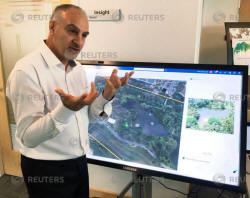Virtual Singapore project could be test bed for planners
- and plotters
 Send a link to a friend
Send a link to a friend
 [September 28, 2018]
By John Geddie and Aradhana Aravindan [September 28, 2018]
By John Geddie and Aradhana Aravindan
SINGAPORE (Reuters) - With the click of a
button, Singapore's security forces could soon use a digital version of
the city-state to simulate a bomb threat at a sports stadium - and learn
how to respond if there was a real attack.
Yet officials worry that "Virtual Singapore" - available soon to state
agencies before an eventual public rollout - could also aid would-be
terror plotters which the government says have their sights set on the
wealthy island.
This is just one of many security conundrums facing developers of the 3D
model that will be fed by big data and could assist in everything from
urban planning to disaster mitigation in the city of 5.6 million people.
Developers and experts say the scheme is one of the most ambitious of
its kind and will be watched by other cities hoping to use new
technologies to improve the lives of citizens.

"This information will help our daily lives, but it could also fall in
the wrong hands and create problems for Singapore," said George Loh,
director of programs at the National Research Foundation, a department
in the Prime Minister's Office which has been leading the project's
development for over three years.
"We need to think about that. We need to be two or three steps ahead,"
Loh told Reuters.
He said some officials considered the system "too dangerous" because
militants, for example, may try to access details like the height or
view from buildings to plan sniper attacks.
Cybersecurity was also a concern after the country suffered its biggest
data breach this year in which 1.5 million people including the prime
minister had information stolen.
Virtual Singapore will be restricted to computers not connected to the
worldwide web, so-called 'internet separation', when it is rolled out to
government offices in the coming months.
The problems become more complex when deciding on the amount and
accuracy of the data that will be available to citizens using the 3D
model at a later date.
"If it is not accurate enough, nobody will use the platform. But if it's
too accurate, then there's a problem. The question is the tradeoff and
how we address the threats that we would face," Loh said.
[to top of second column] |

Alexandre Parilusyan of Dassault Systemes showcases Virtual
Singapore, a detailed 3D model of the city-state that will be fed
with big data and could assist in everything from urban planning to
disaster mitigation, at the National Research Foundation offices in
Singapore September 21, 2018. Picture taken September 21, 2018.
REUTERS/John Geddie

ROLE MODEL?
With a stable, centralized government, Singapore is seen as an ideal testing
ground for new technologies. But some plans, such as a network of surveillance
cameras with facial recognition software, have stoked privacy concerns.
Scott Hawken, a lecturer in urban development and design at the University of
New South Wales in Australia, said Virtual Singapore was among "the most
advanced and comprehensive" 3D mapping projects and was seen as a model by other
countries.
However, he cautioned that such technologies also raised serious questions about
privacy, surveillance and security.
The S$73 million ($53 million) Virtual Singapore scheme is part of the
government's "Smart Nation" plan to use cutting-edge technology to improve
people's lives. The government has pledged to be sensitive to privacy, and Loh
said some data on Virtual Singapore may be anonymised to address those concerns.
Alexandre Parilusyan of Dassault Systemes, a French software firm working on the
project, said other cities have used 3D modeling to address problems like
transport planning, but the scale and ambition of Virtual Singapore makes it
unique.
Among its future uses, the 3D model could predict the spread of flash floods in
the city, or simulate how microwaves travel through high-density areas and
certain building materials to help detect dark spots in cellular network
coverage.

"When you look at what Singapore is doing today, you are already looking to the
future in the crystal ball," he said.
(Reporting by John Geddie and Aradhana Aravindan; Editing by Darren Schuettler)
[© 2018 Thomson Reuters. All rights
reserved.] Copyright 2018 Reuters. All rights reserved. This material may not be published,
broadcast, rewritten or redistributed.
Thompson Reuters is solely responsible for this content. |